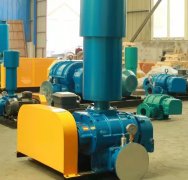Roots blower impeller
As a common industrial equipment, one of the core components of Roots blower is the impeller. The following is a detailed introduction to the impeller of Roots blower:
1、 Definition and Structure
The impeller of a Roots blower is a rotating component installed on the main shaft of the blower, consisting of a series of blades arranged at angles and intervals to ensure effective compression and delivery of gas during blower operation. The common types of Roots blower impellers are three bladed and two bladed. The three bladed impeller performs three suction and exhaust operations with two impellers per rotation. Compared with the two bladed impeller, the three bladed impeller has lower gas pulsation, vibration, and noise.
2、 Working principle
The working principle of Roots blower mainly relies on the relative motion of two blade rotors (usually three bladed impellers) in the cylinder to compress and transport gas. The specific process is as follows:
1. Impeller rotation: When the motor drives one of the impellers to rotate, the other impeller will rotate synchronously at the same speed and in the opposite direction through the action of the synchronous gear.
2. Gas suction and compression: Due to the gaps between impellers, impellers and casings, and impellers and wall panels, a vacuum state is formed at the inlet during the rotation of the impeller, and air is sucked into the inlet chamber under atmospheric pressure. As the impeller continues to rotate, two of the blades of each impeller form a sealed chamber with the wall panel and casing, and the air in the intake chamber is continuously carried to the exhaust chamber by the sealed chamber formed by these two blades. Also, because the impellers in the exhaust chamber are interlocked, the air between the two blades is squeezed out.
3. Gas exhaust: Through continuous inhalation and compression, air is continuously transported from the inlet to the outlet, completing the entire gas transportation process.
3、 Importance
The impeller plays a crucial role in Roots blowers. When the fan is running, the impeller generates centrifugal force through rotation, sucks in and compresses the gas, and then delivers it to the outlet. The air volume of a Roots blower is proportional to its rotational speed, so the rotational speed of the impeller directly affects the gas delivery capacity of the blower.
4、 Application Fields
Roots blowers are widely used in aquaculture oxygenation, sewage treatment aeration, cement conveying, pneumatic conveying, flue gas desulfurization and denitrification, ventilation, waste gas treatment, biomass gasification, mining exhaust and other fields. In exhaust gas treatment, Roots blowers can be used for processes such as conveying, ventilation, and dust collection; In biomass gasification, Roots blower is used to transport biomass particles, drive gas circulation, etc; In water treatment, Roots blowers are used for processes such as aeration, agitation, and phosphorus removal; In mine ventilation, Roots blower is used to remove harmful gases from the mine.
5、 Development Trends
With the continuous advancement of technology and industry, Roots blowers are also constantly innovating and developing. Some manufacturers have installed intelligent control systems on Roots blowers, which can achieve remote monitoring, automatic adjustment, and other functions, improving work efficiency and reducing labor costs. At the same time, the application of new materials has also improved the wear resistance and corrosion resistance of Roots blowers. In the future, Roots blowers will develop towards a more energy-efficient and intelligent direction.
In summary, the impeller of a Roots blower, as the core component of a fan, plays a crucial role in gas compression and transportation processes. Its simple structure, convenient manufacturing, and stable performance have made Roots blowers widely used in multiple fields.



